It has become a prevalent trend to use rocks or stones in a fish tank as you can purchase a lot of different shapes, sizes, and colors according to your liking at your local pet store. Just make sure that the rocks you add are not dangerous, especially if they are full of chemicals and other minerals that can kill your fish over time.
Table of Contents
Something to keep in mind:
- Always make sure to avoid rocks with sharp edges and with tiny pores. You may round off the edges of stones with sandpaper.
- Genuine stones will displace the water and weight of oxygenated water for your fish. Thus artificial rocks are better if you do not have a lot of resources or time to prepare your tank.
- Do not overload your tank with heavy rocks, as this may crack the aquarium glass or the aquarium stand that your aquarium is supported by because it may not hold the extra weight once you add the water.
- Always remember to clean any rocks or stones before adding them to your fish tank. Then, allow them to soak in boiling water for ten minutes to eliminate all the unwanted algae, bacteria, fungus, or parasites they may contain.
- Add a level of gravel or sand before placing your rock in your tank to avoid breaking or cracking the glass.
- Make sure your stones are secure in the substrate or the wall of your tank to prevent them from falling over.
- Before and after the water has been added, be sure to check that all your rocks are secure enough and will not break loose or move.
To help you choose the best rocks for your tanks, we have compiled a list of all the different kinds of aquarium rocks and their effects on your tank.
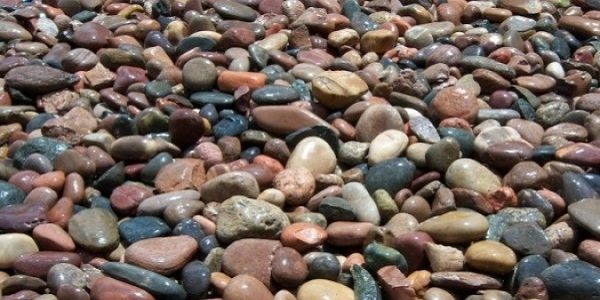
There are two basic types of rocky fish tanks, but generally, you can add rocks to any aquarium. The two main styles include the Ishigumi style and the Iwagumi style.
There are also two types of rocks for saltwater and freshwater aquariums. Common saltwater rocks are Fiji, Pukani, Aquacultured Live Rock, etc. Similarly, common freshwater rocks are slate, lava, quartzite, etc.
Read this article carefully to understand which rock will be best suited for your tank.
Three Types of Aquarium Rocks
There are three main categories for the types of rocks we can use in our fish tank, which each have their sub-category. They include sedimentary, igneous, and metamorphic rocks.
Igneous Rocks
Igneous rocks are crystalline. They are created through cooling and solidifying molten earth. In an aquarium setup, Igneous Rocks can include dolerite, gabbro, and basalt.
Sedimentary Rocks
Sedimentary rocks form after many layers of particles, cement, and deposits. These types of stones include marl, limestone, sandstone, breccia, conglomerate, and shale.
Metamorphic Rocks
Metamorphic rocks emerge after the continuous process of heating and cooling when the rocks undergo pressure. These rocks include quartzite, dolomite, marble, phyllite, slate, schist, gneiss, and hornfels.
Depending on the biotype, all of these rocks should be suitable for a fish tank.
Aquarium Rocks That Alter Chemistry
As surprising as that sounds, you will have to be extra careful while choosing rocks for your tank, as some rocks can significantly change the pH of your water and either soften the water over time or harden them.
Rocks that soften water and lower the pH
If your primary purpose is to lower the pH in the water and soften it, you will need aquarium rocks such as basalt, sandstone, and even granite.
Rocks that harden the water and increase the pH
In contrast, if you want to harden the water and increase the pH, then use rocks like limestone and marble.
It is interesting to know that sandstone, granite, slate, and basalt can be used for low or soft pH levels in aquatic water conditions. You can use marble and limestone when the water needs buffering in challenging water environments with high pH levels.
Other famous rocks that people use in their aquariums include lava rocks, which can be used to fertilize aquatic plants. Slate ages very well in fish tanks but can have very sharp edges. Granite is also a safe type of rock but can be very heavy on the glass of your tank.
Rocks for Aquascaping
As mentioned earlier, different socks have different effects on the water and the temperature of the tank. While picking perfect rocks for your tank for aqua-scaping, you should know that some stones will spread calcium in the tank or increase the hardness of the water. As we have seen, some may lower or raise pH. Some stones might let out carbonates too! Let us take a look at some rock options.
Slate and shale
Slate and shale are readily available in pet stores and used widely. They often are mistaken for each other, but they both have defining characteristics. Shale forms after a long process involving millions of years when particles such as clay, quartz, etc., mix and undergo pressure. Shale has many colors such as grey, yellow-brown, red. It is breakable and easy to lift.
Slate, on the other hand, forms when shale is buried under cover of more sediments. Slate is found in areas with volcanic activity. Slate has streaks of colors, such as green, dark red, and grey. Unlike Shale, Slate is more rigid and not easily breakable. Shale is used a lot in creating modern architecture, such as for flooring, roof shingles, pool tables, billiards tables, walkways, etc. The main reason for this is that it’s pretty durable.
Slate is very commonly available for aquariums and is sold everywhere in slabs.
The best thing about Slate is that these rocks will not change the water conditions in the tank, and you can use them to create faux structures in your tank (such as cliffs or steps).
Lava rock
Lava Rocks are a popular choice, especially for cichlid tanks. Lava rocks, as their name suggests, are formed after melting and cooling down over thousands of years. A lot of useful bacteria generally grow within them.
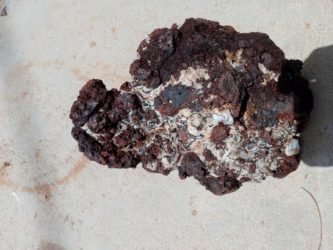
Lava rocks have pores and make for a good addition to a tank. The valuable bacteria help in regulating nitrates within the tank and keep the water toxin-free. You should consider lava rocks if you want to keep your nitrate levels in check.
Lava rock is also solid, and will not release any calcium into the tank.
Quartzite
Quartzite is safe for most planted tanks. Quartzite is formed when the quartz sandstone undergoes heat and pressure. Quartzites also have many different color names such as onyx bamboo, glacier wave, platinum black, etc. It is a striking rock with a high decorative value. It is an excellent rock to have in your tank due to its brilliant hues.
Petrified wood
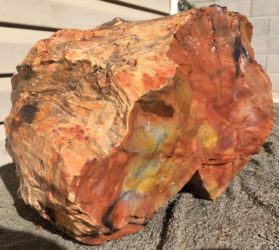
Petrified wood is none other than wood fossils. When trees get buried in the soil without decaying (as there is a lack of oxygen), the wood gets ‘petrified’ with minerals such as pyrite, calcite, etc. It erodes the wood and leaves some patterns on the petrified bark, which almost turns into solid rock. Petrified wood looks like a log of wood but with different hues like brown or dark orange. It also does not disturb the water and acts like a big hiding space for fish.
Glass rock
Glass rock is also called ‘fire rock’ and is an artificial substance. Glass rocks are used highly in aqua-scaping as they come in multiple colors and sizes. You can even use it as a gravel substrate to give the tank a splash of color. Like the previously mentioned rocks, glass rock will not damage the existing tank conditions.
Texas holey rock
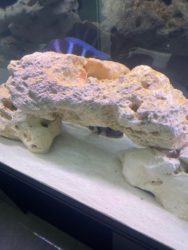
Naturally, this rock can be found in Texas and contains a lot of holes. The rock is made of limestone, so this is one of those rocks that will increase your water’s pH over time. It works best for African Cichlids and is found in their wild habitat too. Having the Texas Holey rock will give your African Cichlids a sense of home.
Rainbow rock
Rainbow rocks are colorful and are sedimentary. They are from Mexico and although they are not suitable for a natural look in the tank, they are quite popular! They will not destabilize the pH levels in your tank.
Mountain Stone
Mountain stone is famously found in Takashi Amano’s aquariums. The colors of this rock are different shades of grey and look like small mountains in the tank. But, they contain calcium carbonate; this might increase carbonates in the water. Therefore, it is used for decorative purposes only after acid washing it once.
Plastic rocks
Plastic rocks are cheaper and safer alternatives to natural rocks. These are made from resin molds in natural colors. They are also easy to clean and look natural in small aquariums. They are used around plants a lot to keep them attached to the surface.
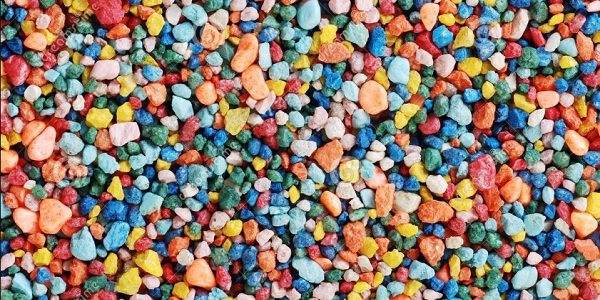
Rocks for Saltwater Aquariums
Fiji Rock
Fiji Rocks are common live rocks. They are mainly put into reef tanks. Fiji rocks are light and, therefore easy to use. But, they are not widely available due to the long time it takes for your shipment to reach you.
Tonga Branch Rock
This rock is a heavy rock variety with a distinct antler shape. Tonga Branches are used as centerpieces in most tanks and decorated with algae for more significant effect.
Pukani Rock
Pukani Rock also comes from Fiji but is less heavy and more porous. The rock structure makes it fun for fish to play around and hide in the holes. This live rock is also decorated with algae on it to eventually, inside the tank, it will grow its ecosystem!
Aquacultured Live Rock
These rocks are more artificial than naturally occurring. The debris falls into the sea, which eventually comes together and is inhabited by aquatic life. These rocks are therefore safe for saltwater tanks and will not harm your fish.
Dry Rock
As its name suggests, Dry Rock is dry and can be transformed into a live rock by a careful ‘curing’ process. Once that is done, you can use it in your tank well.
Life Rock
Life Rocks are essentially dried reef rocks. They often have a purple coating on them, giving them a look of being algae-covered. Because of its bright hue, it livens up a tank and is a great option!
Popular aquarium rocks
Seiryu Stone
Seiryu Stone is also sometimes called ‘Azure Dragon.’ This rock, from Pisces, is best for freshwater tanks. The set contains a total of six to seven rocks. These rocks come in varying shapes and sizes, giving you more freedom to decorate them in the tank you want. It is a great decoration to lend a natural look to the aquarium.
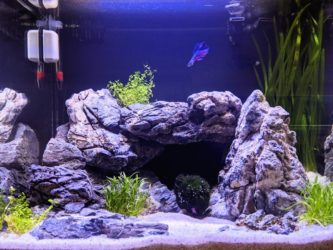
Make sure to wash it thoroughly before putting it in the tank. There are some reports of this rock raising the pH of the water, so we advise caution.
Natural slate
Natural Slate is one of the most popular choices for any aquarium. Not only is it commonly available, but also they are safe for your fish as they do not create any imbalances in the tank. Slate is a naturally occurring stone, as mentioned earlier. Unlike the artificial rock options, this one will not harm your tank or spread toxins in it. You can easily buy up to five pounds of slate in each package. You can spread them at the bottom or even place them in such a way that they support your plants.
Slate is the best option for any kind of aqua-scaping. Many hobbyists use it to create walkways or hidden corridors for the fish to hide in.
Aqualexs Aquarium Ohko Dragon Stone
Just as its name suggests, the Ohko Dragon Stone is a fierce-looking rock that lends a natural texture to your tank. In the Aqualexs pack, you will get a couple of large pieces and some smaller pieces to decorate as you wish.
But, before adding to your tank, make sure to wash it thoroughly. It will help in preventing any rise in the pH of your tank’s water. It is pretty safe in most aquariums and should not cause any problems for your fish.
Get it here on Amazon.
CaribSea South Sea Base Rock
This rock from the South Sea Base is ideal for tanks that house cichlids and reefs. These rocks form under the pressure of limestone as a result of erosion and formation. This process takes millions of years and gives the rock a unique look. These nooks and curves are a great way for your fish to enjoy and explore their tank. Just like slate, it is safe and will not create pH imbalances in the water.
Just like slate, this is also a naturally occurring rock so that it will give your tank a natural look. In addition, it is pretty long-lasting and adds an aesthetic value.
Billy’s Dry Reef Rock
Billy’s Dry Reef Rock is one of the most affordable options for dry rock. Billys Reef Connection, the manufacturers of this variant, boast of handpicking each rock and testing it in their labs to ensure it is 100% clean.
The rock is porous and made of aragonite-based reef rocks. Made in Florida, this is an excellent option for the price tag and you can add them to any existing fish tank.
CaribSea Life Rock
Just like its previously mentioned companion, Life Rock also comes from the South Sea. It is also a natural rock and the most recommended choice amongst aquarists. The purple color that shines in a pale, golden light is pretty to look at. The stone, due to its formation, created whorls of space in the middle. These whorls are a favorite among fish to hide.
CaribSea Life Rock is also a clean, freshwater rock. The 50% of the gaps in the rock make it a popular choice for small fishes to play.
Beachcombers Coral Centerpiece
This option is more of a show-stopping attraction. Manufactured by Beachcombers, it is a large coral rock. It weighs 1.25 pounds. As mentioned earlier, it acts as more of an appeal than anything else. It is safe to wash it and put it in the tank, but it seems too light-weighted and you will have to handle it with caution.
Washing and conditioning rocks
Scrubbing with a brush
One of the efficient ways of cleaning a rock is to scrub it with a stiff brush. However, if the rocks have tiny pores, consider using a more delicate brush or a toothbrush to get the grime off.
Soaking in pure water
Soaking rocks in pure water is important because it erases any chance of them still having any leftover bacteria. Remember not to use any soap because you will have a hard time getting the soap bubbles off. Some soaps may even contain harmful chemicals that you do not want your fish to come in contact with.
Washing rocks with boiling water
Boiling water is hardly used to wash rocks. The reason for this is sometimes the high temperature of the water might cause the rock to crumble or even explode! If you still decide to do this, then wear protective clothing and process with caution.
Bleaching rock
Bleaching the rocks is the most popular method and the most efficient one. Bleach will not only kill any insects or worms hidden inside but eliminate any micro-organisms from the rock. To bleach your rocks, first, scrub them with a brush, and then soak them in bleach for around 10 to 15 minutes. Next, rinse them well with water, and then wash the rocks again in dechlorinated water for at least 24 hours to remove the bleach remnants.
Acid washing
Acid washing rocks is also a valuable way of ensuring that they are clean for the tank. To acid-wash, first, wash it with water and pour some more water in a container. Then, add the rock, and wash it over with muriatic acid. Once you are done washing it with the acid, soak the rock in tap water for 24 hours and sun-dry it well.
Remember that acids are dangerous and so, please wear protective gear when attempting this on your own. Always do this process outside so that you do not inhale any acidic fumes.
Can we use rocks found in nature?
Using rocks found in nature in your tank is not advisable. For one, you do not know what kind of micro-organisms or pathogens those rocks could contain, as they are not chemically treated yet. Secondly, they may also have pH-changing qualities, which can prove fatal to your fish. Therefore, we recommend you only use the rocks which are selected carefully for different aquarium types.
Conclusion
While adding rocks or stones to an aquarium is becoming a viral trend, it is always wise to do a little research before purchasing or collecting random rocks. Make sure that your rocks are fish and aquarium-friendly. If you have trouble selecting your rocks or identifying them, you can ask your local aquarist for assistance. Always clean any rock before adding them and if you have done all that you can do to ensure your rocks are safe, add a twist with a rocky vengeance to your tank. They are guaranteed to make any tank look breath-taking.

1 thought on “Types of Fish Tank Rocks – Aquascaping, Salt-Water, and Natural”
Great advice on rock safety. Thank you.